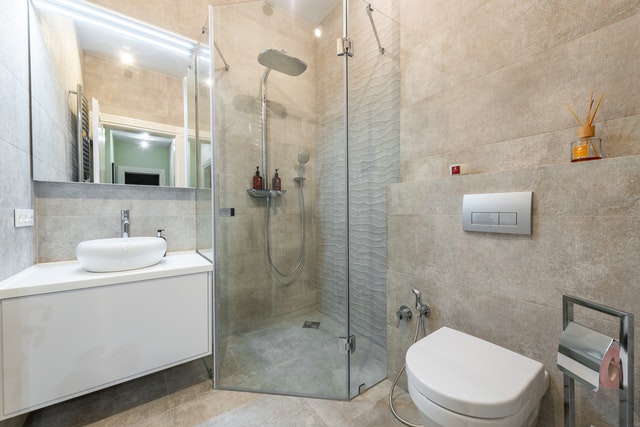Light, Heat, And Ventilation
Imagine yourself stepping out of your shower or tub into an unheated, unventilated, dark bathroom—probably how your great-great-great-grandparent did once upon a time. Fortunately, even the smallest bathrooms today have heat, ventilation, and light. And they are far more sophisticated than ever.
Bathroom lighting has become much more complex in recent years, especially in large master suites. No longer is a four-bulb light bar at the vanity mirror and a single recessed light above the shower considered sufficient for a larger room.

While you’ll find more multifaceted lighting systems being designed into bathrooms today, you’ll also come up against more stringent energy use codes for planning them. If the bathroom lighting is not high efficacy (LED or fluorescent for lower wattage requirements), many municipalities require an occupancy sensor as the main control. This has driven the development of lighting technology that delivers both illumination and low power demands.
Ventilation is essential, too. It ensures that the air you breathe is fresh, whether it’s coming from a fan an open window, or both. A poorly ventilated bathroom is at much greater risk of developing mold problems, which can be extremely dangerous.
Heating keeps you comfortable, especially when you’re wet. Be sure to factor it into your bathroom project so that it’s as inviting as the rest of your home. It will either be tied into your home’s central heating system or something added just for that space, like radiant floor heat.
Lighting types
Lighting should be planned in layers with ambient light illuminating the entire space, task lights focusing on key areas, night-lights providing safety and comfort, and even accent lighting playing up key features.
Ambient lighting
Ambient light most often comes from recessed ceiling lights. Master baths may include decorative lighting fixtures like chandeliers, but code restrictions for such lighting exist to avoid fatal shocks when standing in a tub.
The most natural ambient light comes from the sun, which may shine into your bathroom through windows or standard or tubular skylights. Both skylight types—the large familiar rectangular and newer smaller tubes—can greatly enhance your space with warmth and brightness. The standard skylight is expensive to purchase, install, and maintain. This has led to the development of tubular skylights, which require a much smaller hole in your roof.
Task lighting
Vanities once lit mainly by light bars might now get pendants or sconces instead. Sconces and pendants should be installed with the users’ height in mind to best illuminate their faces.
Task lighting might also be installed inside cabinets to make it easier to see their contents. Task lighting above the shower makes bathing easier.
Accent lighting
Accent lighting in bathrooms may take the form of a lighting strip below a floating vanity, along its façade, or in the toe kick of a standard cabinet to provide night-lighting. It may also be tucked behind a ceiling detail to cast a soft glow. Accent lighting may even become installed in an upscale tub or showerhead as chromatherapy lighting.
Heating
In no other room is heating as to be both naked and wet on a regular basis. Getting out of a shower or tub or even just stepping barefoot onto a tiled bathroom floor can be chilling experience—especially in colder seasons-and the bathroom’s heating system needs to offset this as quickly and efficiently as possible. Fortunately, there are several excellent options available to heat this space in conjunction with your home’s central heating system or on their own.
In many American homes, a central gas, solar, or electric-powered heating system provides basic comfort for a dressed user and for a smaller bathroom. During a remodel these can be supplemented with a radiant floor heating system installed in the bathroom floor. Newer offerings allow you to install conductive mat systems below your flooring surface and operate them on their own controls. The mats heat up the flooring and the flooring heats up the room. Some new models can be programmed from your smart phone. Be sure to talk with your flooring and radiant system suppliers to make sure the combination is workable. Not all flooring materials are ideally suited for this purpose.


Some bathrooms add heat through an integrated fan/heat/light fixture that serves multiple purposes. These are often installed near the shower to avoid that pre-dry-off chill. Be sure to consult with an electrician as a new hating system, even one combined with a vent fan, could require a new dedicated circuit.
Water Heaters
Heating a home’s water can consume a significant portion of its energy costs, so it’s important to plan carefully. Some remodeling projects can take advantage of the existing system, but if you’re adding a tub or multiple showerheads where none existed before, it is important to review whether the current capacity will meet the new demand.
Many bathroom additions require an expansion of your water heating system. In some cases, a larger tank can replace the existing model and meet the need. In other instances, especially with room additions and attic or basement conversions, a supplement is required. Tankless water heaters are often used to meet this need.
Also called a demand or instantaneous heater, a thankless water heater doesn’t store and constantly heat water, so it can be an energy-efficient add-on? It will cost more than a standard hot water storage mode, but it can last longer and will hit your utility bills less. Thankless heaters can be gas-or electric-powered, depending on what’s available in your area. They are also Energy Star-rated, so you can gauge how much they’ll impact your utility bills.
Ventilation
Effective bathroom ventilation is essential for your health, especially in spaces with tubs and showers. Without it, harmful or even deadly mold can develop. Good ventilation will also pull unpleasant odors from the room, which is why you’ll find vent fans even in windowless half baths.
Depending on the size and layout of your bathroom, you may need more than one exhaust fan. Separate water closets without operable windows and steam showers should have their own, for example.

There are codes and guidelines on how much capacity is needed. Ventilation is measured in cubic feet per minute, commonly called CFM. While a standard 5-foot by 8-foot bathroom would seem to require just 40 CFM, the minimum recommendation is 50. Ventilation for larger bathrooms can be determined by the number of fixtures. The Home Ventilating Institute (GVI) suggests 50 CFM minimum each for toilet, shower, and soaking tub, but 100 CFM for a jetted tub.
Your bathroom will also need a source of make-up air for the humid air that’s pulled out. This can come from an open window or operable skylight or from the space between the door and threshold. There should be at least ¾ inch of space for a windowless room.





